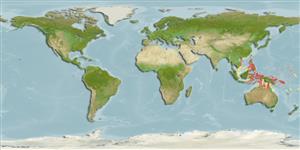Môi trường / Khí hậu / Phạm vi
Sinh thái học
; Biển Sống nổi và đáy; Mức độ sâu 20 - 38 m (Ref. 78591). Tropical, preferred ?
Western Pacific: Papua New Guinea and Marshall Is.
Bộ gần gũi / Khối lượng (Trọng lượng) / Age
Maturity: Lm ? range ? - ? cm
Max length : 4.0 cm SL (female)
Short description
Hình thái học | Sinh trắc học
Các tia vây lưng cứng (tổng cộng): 7; Các vây lưng mềm (tổng cộng): 17; Tia cứng vây hậu môn 1; Tia mềm vây hậu môn: 18. This species is distinguished by the following characters: D VI-I, 17; A I, 18; pectoral rays 18; scales in longitudinal series 78; scales absent on head, nape, or prepectoral area; body elongate, its depth 6.6 in SL; dorsal spines progressively longer to fourth, 4.05 in SL; caudal fin pointed and moderately long, 3.0 in SL; pectoral fins reaching to above anus, 3.8 in SL; pelvic fins not reaching anus, 4.65 in SL (Ref. 75899); characterized further by male with bluish body color, white abdomen, head and body covered with yellow spots, blue mid-dorsal stripe on head, yellow spotting on dorsal fin; female similar to male except for having irregular dark spots on first dorsal fin and yellow streaks instead of spotting; united pelvic fins, presence of well developed frenum; body covered with cycloid scales anteriorly, ctenoid posteriorly (Ref. 90102).
The alpheid Alpheus cf rapacida is the symbiotic snapping shrimp that shares the burrows with this species in both Papua New Guinea and Majuro (Ref. 78591). Found in estuaries, lagoons and sheltered reefs (Ref 90102).
Life cycle and mating behavior
Chín muồi sinh dục | Sự tái sinh sản | Đẻ trứng | Các trứng | Sự sinh sản | Ấu trùng
Randall, J.E., 2007. Descriptions of four new shrimpgobies of the genus Vanderhorstia from the Western Pacific. Aqua Int. J. Ichthyol. 12(3):89-100. (Ref. 75899)
IUCN Red List Status (Ref. 115185)
CITES (Ref. 94142)
Not Evaluated
Threat to humans
Harmless
Human uses
Thêm thông tin
Age/SizeSự sinh trưởngLength-weightLength-lengthLength-frequenciesSinh trắc họcHình thái họcẤu trùngSự biến động ấu trùngBổ xungSự phong phú
Các tài liệu tham khảoNuôi trồng thủy sảnTổng quan nuôi trồng thủy sảnCác giốngDi truyềnTần số alenDi sảnCác bệnhChế biếnMass conversion
Các công cụ
Special reports
Download XML
Các nguồn internet
